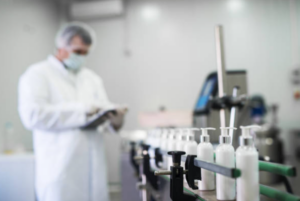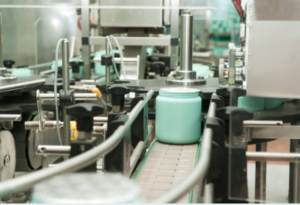The Carbon Footprint of Cosmetics

In the world of beauty, we often focus on the ingredients, formulations, and effectiveness of our favorite products. But have you ever stopped to think about the environmental impact of your cosmetics? The beauty industry, like many others, has a significant carbon footprint, and it’s crucial to understand how the manufacturing process of cosmetics can contribute to climate change. In this blog post, we’ll dive deep into the world of beauty manufacturing, exploring the environmental implications, the strides the industry is making to reduce its impact, and how consumers can make more sustainable choices.
The Environmental Toll of Beauty Manufacturing
The beauty industry is massive, with countless products lining the shelves of stores and filling our bathroom cabinets. From skincare to makeup, haircare to fragrances, the production of cosmetics is a complex and resource-intensive process.
1. Ingredients Sourcing:
The quest for exotic and beneficial ingredients in cosmetics often leads to the extraction and sourcing of natural resources. For example, palm oil, a common ingredient in skincare and makeup products, is obtained from palm trees primarily grown in Southeast Asia. The expansion of palm oil plantations has been linked to deforestation, habitat destruction, and the endangerment of various wildlife species. In addition, some ingredient harvesting practices can disrupt delicate ecosystems. For instance, the collection of seashells and marine extracts from coral reefs can harm these fragile underwater habitats.
2. Energy Consumption:
Cosmetic manufacturing facilities are major consumers of energy. From the mixing and blending of ingredients to the heating and cooling of product formulations, significant amounts of electricity and gas are required. Moreover, these facilities also consume water for a range of purposes, including temperature control and steam generation. The energy-intensive nature of cosmetic production contributes to its overall carbon footprint.
3. Transportation:
The global supply chain for cosmetics involves the transportation of raw materials, ingredients, and finished products across the world. Goods travel by sea, land, and air, and each mode of transportation contributes to the industry’s environmental impact. Shipping and airfreight are energy-intensive processes, and the sheer distance that cosmetics travel contributes to the carbon emissions associated with the industry.
4. Packaging Waste:
The beauty industry is notorious for its excessive packaging. Many products come in containers that are often non-recyclable or designed for single-use. The proliferation of plastic packaging has given rise to a significant waste problem. For instance, face creams, shampoos, and perfumes are commonly found in elaborate, single-use containers that have little regard for sustainability. This packaging waste often ends up in landfills, where it can take hundreds of years to break down.
5. Water Usage:
Water is a vital component in the manufacturing of cosmetics, playing a crucial role in various processes, from mixing to cooling. The beauty industry’s demand for water is substantial, and the excessive consumption of water can strain local water resources, especially in regions already facing water scarcity issues. The untreated discharge of water from manufacturing facilities can also contribute to water pollution, affecting ecosystems and local communities.
6. Chemicals and Pollution:
The production of cosmetics involves the use of various chemicals, solvents, and pollutants. These substances are essential for processes like emulsification, preservation, and coloration. Unfortunately, improper disposal and chemical runoff from manufacturing facilities can contaminate water sources, harm aquatic life, and disrupt local ecosystems.
7. Carbon Emissions:
The most substantial environmental concern in cosmetic manufacturing is the carbon emissions generated throughout the entire production process. These emissions result from energy consumption, transportation, and the manufacturing process itself. The release of greenhouse gases, such as carbon dioxide and methane, contributes to the industry’s significant carbon footprint, which exacerbates climate change.
Understanding these aspects of the environmental toll of beauty manufacturing helps us recognize the importance of making sustainable choices in the beauty products we use and the brands we support. While the industry has a long way to go in reducing its environmental impact, consumers can influence positive change by choosing eco-conscious brands and products.

Sustainable Initiatives in the Beauty Industry
The beauty industry is taking steps to address its environmental impact and adopt more sustainable practices. These initiatives reflect the industry’s growing commitment to reducing its carbon footprint and embracing environmentally responsible practices.
1. Clean and Green Formulations:
Many brands are transitioning toward clean and green formulations. This involves using natural, organic, and sustainable ingredients that are sourced responsibly. By selecting ingredients with minimal environmental impact, companies aim to reduce their contribution to deforestation, habitat destruction, and the disruption of ecosystems.
For example, sustainable brands focus on using ingredients like sustainably harvested palm oil, certified organic botanicals, and cruelty-free substances. They actively engage in supply chain traceability and adhere to ethical sourcing practices, ensuring that their ingredient procurement processes are environmentally responsible.
2. Eco-Friendly Packaging:
The beauty industry is making strides in the realm of packaging, exploring eco-friendly alternatives. Brands are taking innovative approaches to reduce packaging waste, which often contributes significantly to the environmental toll of cosmetics.
- Recyclable Materials: Many brands are now designing product packaging using recyclable materials. These materials can be easily broken down and repurposed, minimizing their environmental impact.
- Refillable Containers: Some brands offer refillable containers that allow customers to reuse the same packaging for multiple product purchases. This approach significantly reduces waste and lessens the demand for new packaging.
- Reduced Packaging: Eco-conscious brands are adopting minimalist packaging designs, avoiding excessive layers of wrapping and packaging. By using only what is necessary, they cut down on waste and the resources needed to produce excess materials.
3. Energy-Efficient Manufacturing:
Manufacturers are investing in energy-efficient manufacturing processes and technologies. These endeavors aim to minimize energy consumption and reduce the carbon emissions associated with cosmetics production.
- Renewable Energy Sources: Some manufacturing facilities are switching to renewable energy sources, such as solar and wind power, to reduce their reliance on fossil fuels. This transition significantly lessens their carbon footprint.
- Energy-Saving Equipment: Companies are updating their machinery and equipment to be more energy-efficient. These advancements enhance productivity while reducing the consumption of electricity and gas.
4. Reduced Water Usage:
Efforts are being made to minimize water usage during the manufacturing process. This includes the development of product formulations that require less water, as well as recycling and treating water used in manufacturing.
- Water-Efficient Production: Sustainable brands design products with reduced water requirements. This not only conserves water but also lessens the environmental impact of wastewater discharge.
- Water Treatment and Recycling: Manufacturing facilities implement water treatment and recycling systems to ensure that water is used responsibly and to prevent contamination of local water sources.
5. Certification Programs:
Various certification programs and industry standards help brands measure and reduce their environmental impact. These certifications act as third-party verifications of a brand’s commitment to sustainability. They enable consumers to make more informed choices about the products they purchase.
For instance, the “Cradle to Cradle” certification evaluates products based on their materials, design, and manufacturing processes, encouraging the development of products with a positive impact on people and the environment. “Zero Waste” certifications incentivize brands to minimize waste in their operations and product packaging.
6. Carbon Offsetting:
Some brands are taking steps to offset their carbon emissions. They invest in projects that contribute to environmental conservation, such as reforestation initiatives or the development of renewable energy sources. These endeavors help counterbalance the emissions generated during manufacturing, allowing companies to make a positive contribution to the environment.
These sustainable initiatives in the beauty industry are steps in the right direction. While challenges remain in making the industry fully sustainable, consumer support for these brands and their efforts can drive further positive change. By selecting products from companies that prioritize sustainability and responsible environmental practices, consumers play a vital role in encouraging the beauty industry to adopt greener and more ethical approaches.

Consumer Responsibility: Making Sustainable Choices
While the beauty industry is making strides toward sustainability, consumers also play a crucial role in reducing the carbon footprint of cosmetics. Here are some actions you can take to make more eco-conscious choices:
1. Read Labels: Look for products with clean and sustainable ingredients. Avoid products that contain environmentally harmful substances.
2. Choose Minimalist Packaging: Opt for products with minimal or recyclable packaging. Consider brands that offer refillable options.
3. Support Sustainable Brands: Research and support brands that have made a commitment to sustainability. These brands often make their efforts clear through their marketing and product labeling.
4. Reduce Plastic Waste: Avoid single-use plastic items and opt for reusable and eco-friendly alternatives, such as bamboo toothbrushes or reusable makeup applicators.
5. Buy Local: Supporting local brands and products can help reduce the carbon emissions associated with transportation and long supply chains.
6. Mindful Consumption: Be mindful of your consumption. Avoid purchasing excessive beauty products that may go to waste.
7. Recycling: Dispose of beauty product containers responsibly by recycling or upcycling them. Many brands now have recycling programs for their packaging.

The beauty industry’s carbon footprint is a significant concern, but it’s heartening to see the steps being taken towards sustainability. Consumers have the power to drive positive change by making informed choices and supporting brands that prioritize the environment.
By understanding the environmental implications of beauty manufacturing and participating in sustainable initiatives, we can collectively work towards a future where beauty and the planet coexist harmoniously. Beauty should enhance our lives, not harm the planet. It’s time to create a more beautiful future for both.

